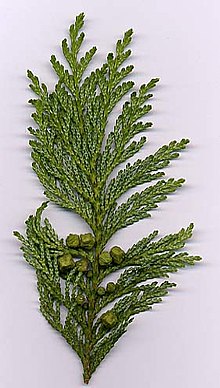Chamaecyparis
| Chamaecyparis | |
|---|---|
 |
|
| Chamaecyparis pisifera foliage and cones | |
| Scientific classification | |
| Kingdom: | Plantae |
| Division: | Pinophyta |
| Class: | Pinopsida |
| Order: | Pinales |
| Family: | Cupressaceae |
| Genus: |
Chamaecyparis Spach |
| Synonyms | |
|
|
Chamaecyparis, common names cypress or false cypress (to distinguish it from related cypresses), is a genus of conifers in the cypress family Cupressaceae, native to eastern Asia (Japan + Taiwan) and to the western and eastern margins of the United States. The name is derived from the Greek khamai, meaning ground, and kuparissos for cypress.
They are medium-sized to large evergreen trees growing from 20–70 m (66–230 ft) tall, with foliage in flat sprays. The leaves are of two types, needle-like juvenile leaves on young seedlings up to a year old, and scale-like adult leaves. The cones are globose to oval, with 8-14 scales arranged in opposite decussate pairs; each scale bears 2-4 small seeds.
Chamaecyparis taiwanensis is treated by many authors as a variety of C. obtusa (as C. obtusa var. formosana).
Genus Fokienia is not always recognized as a separate genus from Chamaecyparis, in which case Chamaecyparis hodginsii (=Fokienia hodginsii should be added to the above list. On the other hand, a species which used to be included in this genus, as Chamaecyparis nootkatensis, has now been transferred on the basis of strong genetic and morphological evidence to the separate genus Xanthocyparis as Xanthocyparis nootkatensis, or back to Cupressus nootkatensis (the name it was originally described under in 1824).
...
Wikipedia
